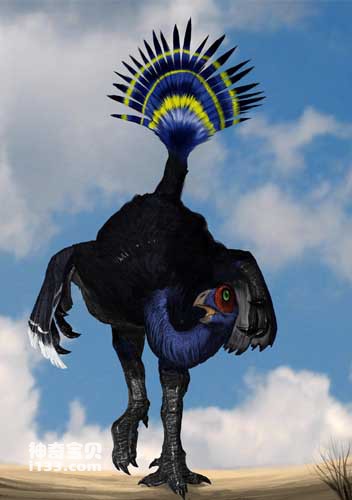Chinese name: Taiyulong
Latin name: Caudipteryx
Age of survival: Early Cretaceous
Fossil origin: Liaoning, China
Physical characteristics: 70 to 90 cm long
Diet: carnivore
Type: Theropod
Definition: A bird with a feathered tail

The discovery of the primitive Archeopteryx, which belongs to the suborder Oviraptorosaurus and is similar to the dromaeosaurid dinosaurs, has preserved feathery skin derivatives for the first time in the world. These discoveries provide important insights into the long-standing issue of the origin of bird feathers. information, allowing our study of the origins and early evolution of feathers to be based on fossil evidence for the first time.
These findings indicate that the original function of feathers was not flight, but keeping warm or attracting mates. Feathers can no longer be used to identify birds. Feathers occurred before birds appeared.
Caudopteryx is a very important discovery. It is similar in size to the primitive Archeopteryx, and even the preserved posture of the fossils is very similar, but they represent two completely different types of animals.
Taiyuyulong has a short and high head, and almost no other teeth can be seen in its mouth except for a few strange-shaped teeth that extend forward at the very front of its snout. The forelimbs of Caudopteryx are very small and its tail is short, but its neck is very long. In its stomach, there is still a pile of small stones, which are the gastroliths commonly found in the stomachs of modern birds, used for grinding and digesting food. Gastroliths are common among birds and other types of dinosaurs, but are very rare among theropods.
The most exciting thing is that there is a bunch of tail feathers arranged in a fan shape on the top of the tail of Caudopteryx, and there is also a row of feathers on its forelimbs. These feathers have obvious rachis and developed pinnae. The overall shape is very similar to the feathers of modern birds; the only difference is that its pinnae are symmetrically distributed, while the feathers of birds including Archeopteryx have Asymmetrically distributed pinnae. It is generally believed that asymmetrical feathers have a flight function. The symmetrical feathers of Caudopteryx may represent a relatively primitive stage of feather evolution.
In fact, the skeletal shape of Caudopteryx is more primitive than that of Archaeopteryx. The shape of the bones behind its head indicates that it was a running animal and could not fly. The latest research shows that Caudopteryx is very similar to the oviraptorosaurs among theropod dinosaurs, and may represent a primitive oviraptorosaur. Oviraptorosaurs were common in the Cretaceous Period in Asia and North America and are a very famous group of dinosaurs in history. Paleontologists initially mistakenly believed that this kind of dinosaur made a living by stealing the eggs of other dinosaurs, hence the name Oviraptor. Later discoveries showed that this kind of dinosaur actually lay on the eggs to incubate its own eggs, rather than stealing other dinosaurs. of eggs. This discovery shows that Oviraptorosaurus had egg-incubating behavior like birds, and ethologically confirms that small theropod dinosaurs and birds are closely related. The discovery of Caudopteryx reminds us that oviraptorosaurs developed true feathers. Recently, paleontologists discovered an oviraptorosaur with a caudal heddle in Mongolia. The main function of the caudal bone is to hold the tail feathers in place, which suggests that all oviraptorosaurs had tail feathers.
The discovery of Archeopteryx and Caudopteryx expanded the distribution of feathers beyond birds for the first time in biological history, indicating that feathers occurred before birds appeared and that feathers can no longer be used to identify birds. If we find a feathered animal fossil in the future, we must carefully observe its skeletal shape to determine whether it is a bird or a carnivorous dinosaur. This is because a feathered animal may not be a bird. It may be a feathered, perching dinosaur. Carnivorous dinosaurs on the ground!
animal tags: Caudipteryx
We created this article in conjunction with AI technology, then made sure it was fact-checked and edited by a Animals Top editor.